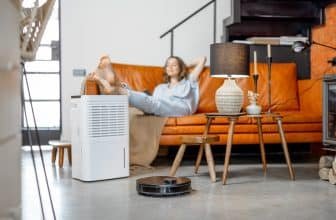High Efficiency Particulate Air: Revolutionizing Indoor Air Quality
High efficiency particulate air (HEPA) filters are vital in keeping our indoor air clean and safe. These filters are known for their ability to capture at least 99.97% of airborne particles as small as 0.3 microns. This makes them incredibly effective in removing dust, pollen, mold, bacteria, and other pollutants from the air.
HEPA filters are commonly found in various devices, such as air purifiers and vacuum cleaners, enhancing the quality of air in homes and workplaces. Understanding how these filters work can help people make informed decisions when choosing the best air purifiers or other filtration systems for their needs.
Maintaining and replacing HEPA filters regularly ensures they continue to work efficiently. This is crucial for minimizing health risks, especially for individuals with allergies or respiratory conditions. Their importance in protecting indoor air quality cannot be overstated.
Key Takeaways: High Efficiency Particulate Air
- HEPA filters remove at least 99.97% of particles as small as 0.3 microns.
- They are used in air purifiers and other devices to improve air quality.
- Regular maintenance is essential for optimal performance.
Principles of HEPA Filtration
HEPA filters are designed to capture a variety of particles, including dust, pollen, and mold spores. They achieve high efficiency by utilizing specific mechanisms that depend on the particle size and the composition of the filter media. These filters must meet stringent standards set by various organizations.
Mechanisms of Particle Capture
HEPA filters use several methods to trap particles, including diffusion, interception, and impaction.
Diffusion occurs when smaller particles, usually less than 0.1 microns, collide with gas molecules, causing them to zigzag and become trapped within the fibers.
Interception captures particles that are too large to follow the air stream around the fibers and thus get stuck. This happens mainly with particles in the 0.1 to 1-micron range.
Impaction deals with larger particles that cannot avoid fibers due to inertia. As the air stream changes direction, these particles collide directly with the fibers and get trapped. Together, these mechanisms allow HEPA filters to achieve high filtration efficiency.
HEPA Filter Media Composition
The media in HEPA filters is typically made from fiberglass or synthetic materials like plastic (PP+PET).
These materials are arranged in a dense, random mat of fibers. The density and fiber diameter are critical for capturing particles of various sizes effectively. Most HEPA filters can capture particles down to 0.3 microns with 99.97% efficiency.
The composition of the filter media also helps in capturing nanoparticles via diffusion mechanisms. Different materials contribute to durability and effectiveness in various environments, including household settings and industrial applications where higher efficiency is required.
Standards and Efficiency Ratings
HEPA filters must meet specific standards set by organizations such as the United States Department of Energy (DOE).
These standards define the minimum efficiency levels. True HEPA filters fall within classes H13 and H14, while ULPA (Ultra Low Penetration Air) filters are classified from H15 to H17, providing even higher efficiency.
Filters are also rated using the Minimum Efficiency Reporting Value (MERV) system. This system assigns a MERV rating that indicates the filter’s ability to capture particles of various sizes.
International standards like the ISO and European Standard (EN 1822) also specify performance criteria, ensuring that filters provide consistent and reliable particle removal. These standards ensure that HEPA filters maintain their efficiency and effectiveness across different applications and conditions.
Application and Usage
High Efficiency Particulate Air (HEPA) filters are used widely in various settings to improve indoor air quality. They are trusted for both residential and commercial purposes, as well as in industrial and healthcare environments.
Residential and Commercial Use
HEPA filters are commonly found in homes and businesses. In these settings, they help maintain clean air by capturing dust, pollen, and pet dander. These filters are essential in vacuum cleaners, air purifiers, and HVAC systems, ensuring that allergens are kept to a minimum.
In offices and commercial spaces, HEPA filters contribute to a healthier environment by reducing airborne particles. This is particularly important in places where indoor air quality can directly impact employee health and productivity. By using high efficiency air filters, even small particles like bacteria and smoke can be effectively trapped, providing cleaner air to breathe.
Air Purifiers and Cleaners
HEPA filters play a crucial role in air purifiers and cleaners. These devices are designed to remove contaminants from the air, and the HEPA filter is key to their efficiency. Air purifiers equipped with HEPA filters can remove at least 99.97% of particles as small as 0.3 microns, including dust, mold, and pollen.
In homes, these purifiers can significantly improve indoor air quality, helping alleviate symptoms for people with allergies or asthma. For both residential and commercial use, HEPA filter-based air cleaners are a popular choice due to their proven effectiveness in trapping harmful particulates.
Industrial and Healthcare Settings
In industrial and healthcare environments, HEPA filters are indispensable. Hospitals and medical facilities use HEPA filters to create sterile conditions by removing bacteria and viruses from the air. These filters are essential in operating rooms and other critical areas to prevent the spread of infections.
Industries like manufacturing and aerospace also rely on HEPA filtration systems. They help maintain a clean working environment, free of particles that could affect both worker health and product quality. In pharmaceuticals and food processing, HEPA filters ensure that contaminants are kept out, preserving the integrity of the products.
Use of HEPA filters in these settings underscores their critical role in safeguarding health and ensuring high standards of cleanliness.
Health and Environmental Impact

High Efficiency Particulate Air (HEPA) filters offer significant health benefits, particularly for individuals with respiratory issues and in reducing the spread of airborne diseases. However, there are concerns related to ozone emissions that must be considered.
Benefits for Allergy and Asthma Sufferers
HEPA filters are particularly beneficial for people suffering from allergies and asthma. These filters can capture dust, pollen, mold, bacteria, and other airborne particles as small as 0.3 microns with an efficiency of 99.97% according to the EPA. This helps to minimize allergens in indoor settings.
By reducing the concentration of airborne allergens, HEPA filters can lessen respiratory symptoms and improve air quality, creating a cleaner environment for those with sensitivities. With fewer irritants, individuals experience less frequent and severe allergic reactions and asthma attacks.
Reduction of Airborne Diseases
HEPA filters play a crucial role in minimizing the spread of airborne diseases, including viruses like COVID-19. These filters can trap fine particles, including many bacteria and viruses, thus preventing them from recirculating in the air.
In spaces like hospitals and clinics, using HEPA filters can lead to significantly improved air quality. This reduction of pathogens in the air contributes to lower infection rates. For schools, homes, and workplaces, HEPA filters can help reduce the ever-present bacterial and viral load, enhancing overall health and safety.
Concerns Over Ozone Emission
Despite their benefits, not all air purifiers are created equal. Some, such as ozone generators and ionizers, can produce ozone, which is a harmful gas. Ozone can lead to respiratory issues and exacerbate conditions like asthma. It is crucial to note that traditional HEPA filters do not emit ozone and are safer in this regard.
When selecting an air purifier, ensuring it uses HEPA filtration without additional ozone generation is vital. According to the CDC, HEPA filters are preferred over those that might emit VOCs or ozone, as they do not contribute to indoor air pollution and are effective in capturing particulate matter without generating harmful byproducts.
Types of HEPA Filters
HEPA filters are divided into several types based on their efficiency and specific use cases. Some of these include True HEPA, HEPA-like, and ULPA filters.
True HEPA vs. HEPA-Like Filters
True HEPA filters are capable of capturing at least 99.97% of particles as small as 0.3 microns. These are officially recognized for their high efficiency in removing dust, pollen, mold, and bacteria. True HEPA filters are often used in medical and industrial applications where maintaining high air quality is crucial.
In contrast, HEPA-like filters do not meet the strict standards set by the Department of Energy. These filters might still provide substantial particle removal, but they are less reliable than True HEPA filters for critical environments. They are more suited for general household purposes, offering good, but not certified, air purification.
ULPA and Other Variants
ULPA filters (Ultra-Low Penetration Air) are more efficient than True HEPA filters. While True HEPA filters capture particles as small as 0.3 microns, ULPA filters can trap at least 99.999% of particles as small as 0.12 microns. This makes them suitable for environments that require extremely clean air, such as cleanrooms and certain medical facilities.
Besides ULPA filters, other air filtration options include activated carbon filters and electrostatic filters. Activated carbon filters are used to remove odors and certain gases, while electrostatic filters use electrically charged plates to capture airborne particles. These alternatives can be combined with HEPA filters to enhance overall air purification.
Maintenance and Replacement
Regular maintenance and timely replacement of HEPA filters are essential. This ensures they continue to work effectively in removing pollutants, dust, and pet dander.
Filter Lifespan and Efficiency
HEPA filters have a varying lifespan depending on usage and environmental conditions. For example, filters in clean rooms might need replacement every three years. Household filters, on the other hand, often need changing every six to twelve months.
Efficient performance depends on adhering to the manufacturer’s recommendations. Ignoring this can lead to reduced clean air delivery rate (CADR) and potential health risks. Filters clogged with dirt and pet dander lose their efficiency, making regular checks crucial.
Best Practices for Replacement
Replacing HEPA filters involves several best practices. First, always turn off and unplug your air purifier before starting. Locate and remove the old filter, checking for dirt and debris. When purchasing a new filter, ensure it matches the make and model of your device.
Follow the steps outlined in your HVAC system’s manual. It’s essential to avoid touching the filter’s pleats with bare hands to maintain its efficiency rating. Replacing filters regularly helps maintain optimum CADR, ensuring sustained removal of pollutants and pet allergens.
Disposal and Environmental Considerations
Disposing of used HEPA filters correctly is important for environmental protection. Many filters are made from materials that shouldn’t end up in regular trash due to potential health risks.
Check if your local waste management services have specific guidelines for disposing of air filters. Some manufacturers may offer recycling programs for old filters. Properly sealing the filter in a plastic bag can prevent the release of trapped pollutants and pet dander during disposal, minimizing environmental impact.
Frequently Asked Questions
High efficiency particulate air (HEPA) filters are known for their ability to trap airborne particles with high efficiency. Below, specific aspects such as benefits in HVAC systems, comparisons with other air purifiers, filter classes, replacement intervals, purchasing considerations, and authenticity checks are discussed.
What are the benefits of using a high efficiency particulate air filter in an HVAC system?
HEPA filters enhance indoor air quality by removing at least 99.97% of dust, pollen, mold, bacteria, and other airborne particles down to 0.3 microns. This leads to healthier living environments and can help reduce respiratory issues.
How does a HEPA filter compare to other air purification systems in terms of effectiveness?
HEPA filters, as defined by the U.S. Dept. of Energy, are more effective than most air purifiers because they can capture smaller particles with higher efficiency. Other systems, like electrostatic or activated carbon filters, may not meet the same rigorous standards.
What distinguishes HEPA filter classes such as H12 and H13?
H12 and H13 are specific classifications indicating their filtration efficiency. H12 filters capture 99.5% of particles that are 0.3 microns in size, while H13 filters capture 99.95%. These distinctions are crucial for applications needing higher levels of particle removal.
How often should HEPA filters be replaced in residential settings?
Typically, HEPA filters in residential settings should be replaced every 6 to 12 months. However, this can vary based on usage, environmental factors, and specific manufacturer recommendations.
What considerations should be taken when purchasing a HEPA filter for allergy relief?
When buying a HEPA filter for allergy relief, consider the filter’s efficiency rating, the size of the area it will cover, and compatibility with existing HVAC systems or air purifiers. Also, look for filters certified to remove common allergens such as pollen and pet dander.
How can one determine the authenticity of a HEPA filter when buying online?
To ensure authenticity when purchasing online, check for certifications from recognized bodies such as the U.S. Dept. of Energy. Also, purchase from reputable retailers and look for detailed product descriptions that specify the filter’s efficiency and particle capture rate.
best air purifiers
My name is Philipp Walz, editor at best-air-purifiers.com, and I’m truly passionate about creating healthier living spaces through smart, effective air purification. For me, air purifiers aren’t just appliances – they’re a quiet revolution in how we breathe, live, and feel at home. Clean air means better sleep, clearer thinking, and fewer allergies. It’s about giving our bodies what they need most: pure, fresh air. I’ve experienced firsthand how the right air purifier can transform a space and improve well-being – and I’m here to help others discover that difference. Because when you breathe better, you live better.






